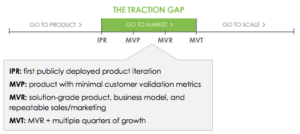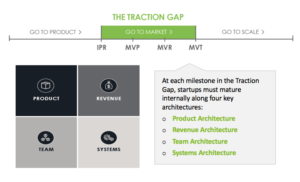How to Halt the Series B Crunch
January 31, 2017
PUBLISHED BY Traction Gap Institute
First, some bad news: A Series B crunch may be upon us. According to Mattermark, in the first quarter of 2016, Series B rounds dropped nearly 40 percent, the largest reduction since the 2008 market correction.
Over the last 30 years, we’ve seen many successful startups accelerate from just an idea to scale in just a few years. On the other hand, we’ve also seen three out of four stall out before ever gaining traction.
While there are many reasons companies fail, the most painful one to watch is when a great product can’t achieve customer traction during the crucial “go-to-market” phase. We call this critical period in the company’s maturity lifecycle “The Traction Gap.” We’ve analyzed these companies and found many of them suffered some combination of small failures associated with product/market fit, team dynamic, revenue model, internal systems or a combination of these.
The Lean LaunchPad, introduced by Steve Blank, and the Lean Startup initiative, led by Eric Ries, have been instrumental in helping early-stage startups make the transition from idea to minimum viable product; this is what we call the “go-to-product” phase. Similarly, Crossing the Chasm, developed by author Geoffrey Moore, has helped later-stage startups advance from selling first to visionaries and early adopters and eventually to Main Street, what we call the “go-to-scale” phase.
The Traction Gap sits between them.
To help companies that find themselves in the gap between product-market-fit and scale, we’ve developed “The Traction Gap Framework” — a methodology for helping startups think through the problems that are unique to companies stuck between product and scale.
According to Correlation Ventures, the overall success rate for early stage startups is less than 25%; where success is defined as returning capital or better to investors. And, other industry statistics suggest the success rate is actually lower.
The Good News is that your company can increase its odds to successfully cross the Traction Gap. Here’s a summary how:
Step 1: Admit That You Have a Problem
For entrepreneurs, the first step in successfully traversing the Traction Gap is recognizing that you are in a Traction Gap and understanding where you are in it. The Traction Gap is the time between initial release of a product and acquiring minimum traction in the market. This minimum traction can be a level of revenue growth, user engagement, number of downloads, usage or other variables that show the market considers the product viable. This signals to investors a positive growth trajectory.
Step 2: Determine Where You Are in the Traction Gap
There are four key “value inflection points” that define the Traction Gap. Reaching each of these points quickly and capital-efficiently requires you to have well-defined plan and set of tactics.

Initial Product Release (IPR) – The IPR is when the startup first makes its product generally available to the public. At this stage, the team is seeking customer validation to prove it is on its way to a minimum viable product. The only employees in the company during this stage should be product-related personnel – founders, engineers and product managers. Most companies require between 12 to 18 months to get from idea to IPR.
Minimum Viable Product (MVP) – This is a debated term, but we define it as the most pared down version of a product that will be purchased or used by customers. The management team should act as the marketing and sales team during this phase. They must learn how to correctly position the company and product, and what it takes to convert interest into demand, usage or revenue. Only after reaching MVP should the company consider bringing on a few dedicated marketing and/or sales resources.
Minimum Viable Repeatability (MVR) – We define MVR as the smallest amount of repeatability a startup can execute to demonstrate its business model is feasible. At MVR, the startup has demonstrated it has some understanding as to “how” and “why” customers are acquired. It now knows a significant amount about its target market, has semi-effective product positioning, a reasonable sales pitch, a handle on the primary sales objections and rational responses to them. While MVR is an “abstract” point in time, the company must set target metrics it believes will establish that it has reached MVR. Only after reaching MVR should a company consider investing significantly in marketing and sales resources.
Minimum Viable Traction (MVT) – Building on its foundation to reach MVT, a company must continue to measure, refine and optimize each of the four core architectures. Most companies need six to eight quarters of sustained growth beyond MVR to reach MVT.
Understanding the Traction Gap and the important steps a company can take to increase value and decrease risk are essential to securing subsequent financing. In my next article, I’ll dive into the architectural foundation that must be in place to gain the momentum required to traverse the Traction Gap.
Do you know where you are in the Traction Gap?
Step 3: Strategically Refine the Four Company Architectures that Help Create Traction
To successfully traverse the Traction Gap, you have to have a well-defined set of objectives that address: product, team, systems, and revenue model:

PRODUCT ARCHITECTURE
Going-to-Market before the product is proven is one of the most common mistakes founders make. Today’s motto of “move fast and break things” works only if you have endless runway. Most founders don’t. Instead, you must ensure that true customer validation is achieved to avoid premature investment in sales and marketing and the accompanying dangerous waste of capital.
Often, in spite of early product acceptance, a team may discover it needs to pivot its product(s), change positioning or add significant capabilities in order to secure sustainable product/market fit in a viable market category. This can result in startups requiring more time and capital before they are ready to scale. More importantly, teams must also have the patience to postpone expensive go-to-market scaling until such fit has been confirmed with significant user feedback, demonstrable usage rates, and customers willing to be references..
REVENUE ARCHITECTURE
Scaling prior to nailing the revenue model can be disastrous for a startup — and its investors. If scaling occurs too soon, the startup can burn through a significant amount of capital with little growth to show for it. This can result in a material down-round, layoffs, significant employee ownership dilution, and even shutdown due to lack of investor interest.
A startup’s revenue architecture is defined by its business model and its ability to secure awareness, engagement, sustained usage, and ultimately convert that into monetization. When a startup reaches a Minimum Viable Product (MVP), it has validated a set of value propositions, but it will likely still be experimenting with business models, programs, and processes that generate awareness/interest and convert into engagement and/or revenue.
For B2C (or B2B2C) startups, this normally translates into testing techniques that optimize lifetime value to customer- acquisition-cost ratios, along with increasing engagement of monthly active users. For B2B, revenue architecture involves strategies to lower customer acquisition costs, identify up-sell opportunities, increase usage rates and declining customer acquisition costs.
TEAM ARCHITECTURE
Getting the team architecture right is key to gaining traction. Many early stage startups have small product-oriented teams and have not yet hired a complete management team or other personnel they need to scale the company. Many times, the wrong people are hired for the wrong role or early team members are unable to scale with the startup.
Before spending vast company resources on expensive growth strategies it’s imperative to ensure the right people are in the right positions, and that anyone who is “out of their depth” receives coaching and training, moved to a role more fitting with their expertise, or exited from the startup.
SYSTEMS ARCHITECTURE
The systems and processes of a startup can either help it accelerate or hold it back. These systems and processes must integrate both front and back offices, establish transparent performance metrics, and cultivate a culture it needs to succeed.
When we invest in early stage startups many are using QuickBooks for accounting, a basic CRM implementation, maybe Wix or a simple eCommerce platform for the web, and perhaps ZenDesk for support. By the time they gain traction, they need to be on sophisticated platforms using much more refined business processes.
In addition to operational systems, startups must ensure they have a well- designed development stack. Very real make or break choices are often made with respect to the engineering management infrastructure that can negatively impact margins and prevent the company from scaling later on.
Wildcat Venture Partners Specializes in Traction Gap Companies
At Wildcat, the majority of our investments are in startups that have not yet traversed the Traction Gap. We seek out and are comfortable working with incomplete teams, lack of product/market fit and immature revenue constructs. We feel this is where we can best leverage our startup operating expertise to generate superior returns.
We enjoy and are successful working with companies at this early stage because we have been investors, company founders and entrepreneurs, operating executives, and consultants with many successful technology startups during their formative years, prior to them traversing the Traction Gap.
We have learned and documented invaluable lessons from our experience with these outstanding entrepreneurs, companies and teams. Our collective experience enables us to quickly identify where early stage startups are located along the Traction Gap and to tailor the set of strategies, tactics, team, and timing to help startups traverse it.
Now we are applying this same approach to systematizing our engagement with startups as they traverse the Traction Gap. We are creating playbooks, workshops, and networking events — led by our team of experienced successful entrepreneurs, startup operators, consultants and notable industry leaders — where our entrepreneurs learn how to successfully meet these challenges.
We’ve also partnered with Velocity, a coaching firm that specializes in helping the CEOs of funded companies transition from being product builders to company builders.
To be sure, there is no “magic formula” for success. Our collective experience and research indicates, however, that the Framework presented above can help accelerate companies across the Traction Gap, quickly and efficiently.
Over the next year, we will be holding a series of events and workshops to train qualifying start-up founders on how to get over the “Traction Gap.” You can find more information about our events here.